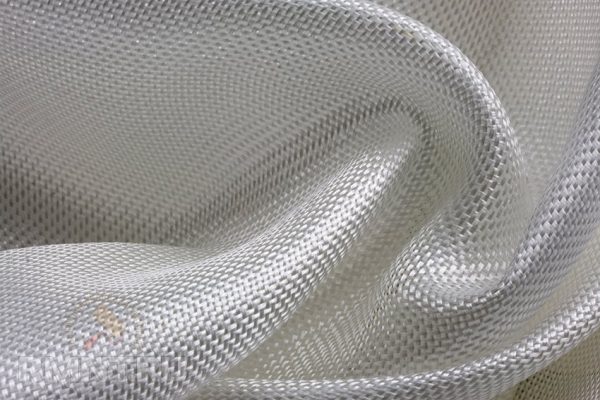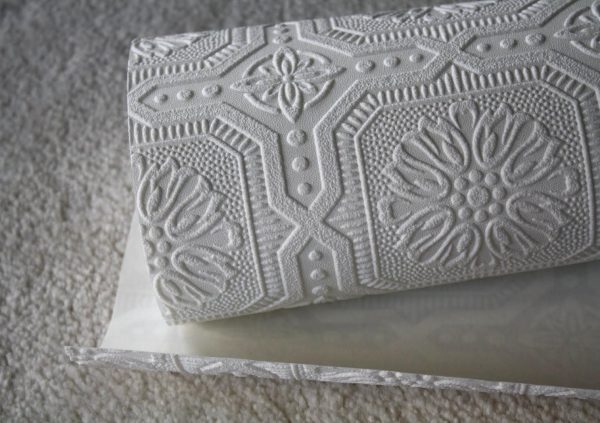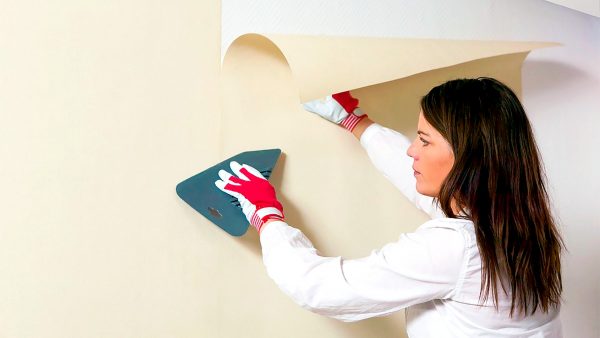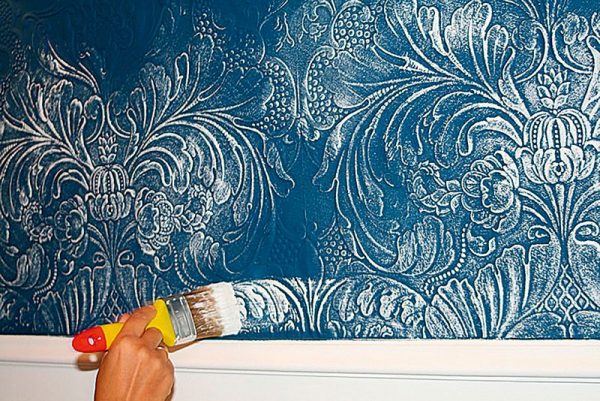Wallpaper for painting - one of the most popular options for decoration. If you want to change the boring interior, such wallpapers do not need to be removed from the walls, it is enough to simply repaint them. Moreover, new layers of paint can be applied repeatedly.
- Varieties of wallpaper for painting
- Non-woven wallpaper
- Cullet
- Paper wallpaper
- Vandal proof wallpaper
- Linkrust
- Criterias of choice
- Room purpose
- Texture
- Wallpapering
- Non-woven
- Cullet
- Paper
- Paint selection
- Wallpaper painting
- Vinyl and non-woven wallpaper
- Cullet
- Paper wallpaper
- Design and colors
- Combined Painting
- Wallpaper shapes
- Venetian plaster
- Style solutions
- Painting wallpaper on the ceiling

Varieties of wallpaper for painting
Non-woven wallpaper
Along with fiberglass wallpaper, non-woven are the most popular among buyers. Such coatings are made from nonwoven material containing cellulose and synthetic fibers. The products have a fine texture, most often applied to foamed vinyl. For non-woven wallpaper, certain pros and cons are characteristic, and the advantages are much more significant.
Advantages:
- subtlety;
- light weight;
- shrink buildings;
- well mask defects on the base surface.
Disadvantages:
- fragility;
- inexpressive texture;
- due to the subtlety, the wallpaper can be stretched during gluing.
Cullet
They are made of fiberglass - a very durable material, which includes such elements:
- caustic soda;
- quartz sand;
- limestone;
- dolomite.
Advantages of cullets:
- high strength, wear resistance;
- ease of sticking to walls;
- fire safety;
- easy care.
The disadvantages of cullet include the following qualities:
- high price;
- weak expression of the picture;
- the need for thorough surface preparation;
- difficulties with the removal of old glass.
Paper wallpaper
The most affordable finishing material. Made of two-ply paper. To create a texture using embossing technology using wooden chips.
Pros:
- environmental friendliness;
- low cost;
- the ability to hide the imperfections of the base surface.
Minuses:
- often torn when glued;
- are deformed when the building shrinks;
- not too durable;
- the service life does not exceed 5-7 years, after which the paintings lose their attractive appearance.
Vandal proof wallpaper
Wallpaper of this variety is distinguished from others by high resistance to mechanical damage. Great for rooms where small children or pets live.
The strength of the material provides a layer of vinyl (made from polyvinyl chloride). Another advantage of the vinyl base is the possibility of repeated repainting of the surface.
Linkrust
Wallpaper of this type is characterized by high decorative properties. Most often they are performed with imitation of plant relief in the form of stucco molding. They are made using rosin, wood flour, wax and chalk.
The advantages of linkrust include such characteristics:
- environmental friendliness;
- antiseptic properties;
- long terms of operation;
- strength;
- resistance to moisture;
- ease of care (can be wiped with a damp cloth);
- outward appeal.
Disadvantages of Linkrust:
- high prices;
- complexity of installation work;
- inability to withstand low temperatures.
Criterias of choice
When choosing a wallpaper for subsequent coloring take into account the following circumstances:
- price;
- material strength;
- roll width;
- predicted service life;
- moisture resistance.
Particular attention is also recommended to be paid to the purpose of the room where the paintings will be glued, and the texture of the material.
Room purpose
Wallpaper is chosen taking into account the purpose of the room. For example, vinyl or paper canvases are great for a child’s room or master bedroom. The former are highly durable, while the latter are environmentally friendly and inexpensive. Also a good option for a children's room is beautiful non-woven wallpaper from wood waste.
In the kitchen, it is most practical to purchase cullet or non-woven coverings. The same products will fit well in the hallway, toilet, corridor, kitchen and dining room.
to contents ↑Texture
Most of the wallpaper for painting has a structure and pattern. The attractiveness of the wallpaper after staining depends on the severity and beauty of the structure. Several painting cycles are allowed. However, it should be borne in mind that the texture becomes less noticeable after each application of paint. The most durable in this regard are cullet that can be repainted 8-10 times.
Also, smooth canvases without embossing are used for painting. To process the walls covered with such wallpaper, use a finishing putty. As a rule, smooth wallpapers are chosen by those who want to create an interior in the style of minimalism or Scandinavian classics.
to contents ↑Wallpapering
Non-woven
First, we close all the windows and doors to the room. This is necessary to avoid drafts. To perform the work, the following materials and devices are necessary:
- wallpaper;
- PVA glue;
- pencil;
- primer;
- roulette;
- knife;
- wallpaper iron;
- primer and glue brush;
- ruler.
There is no need to level the walls before painting, as the paint will mask all minor defects. The surface is carefully primed with 2-3 layers of sealant. This will improve the adhesive quality of the coating. Glue is also bred, but not too much - it should be thick.
Painting wallpapers without a drawing of labor will not be, but if it is available, a fitting card will be needed (it is located on the package). Also on the map there is information about how long the pattern repeats. When cutting wallpaper, a new roll is shifted to the desired distance. The figure below shows a typical material label.
Work execution order:
- We measure the height of the walls. We cut the rolls into fragments using a ruler, pencil and tape measure.
- We start gluing sheets from a window or a remote corner of the room. Using a tape measure, measure the distance corresponding to the width of the roll from the corner. Make a mark with a pencil.
- We glue the place where the first sheet will be strengthened.
- We take the wallpaper canvas and align it along the line marked on the wall with the width of the sheet. Please note: glue does not need to process wallpaper, but the place where they will be glued.
- Level the sheet with your hands and a trowel. We carry out the process with leisurely movements from left to right.
- If there are any obstacles on the wall (pipe, sockets, etc.), use the knife to make appropriate cuts on the sheet.
- Next, repeat the previously performed actions with new sheets of wallpaper. However, now we smooth them from the junction - to the left.
- It remains only to paint the canvas.
Cullet
Fiberglass rolls are most often made in the form of photo wallpaper. The components of the product (dolomite, limestone, soda and quartz) are combined with a paper base, resulting in a finishing material with high consumer characteristics.
We carry out gluing fiberglass wallpaper in several stages:
- We remove the old coating.
- Using high-quality glue, we process a wall section and apply wallpaper to it.
- The fabric needs to be glued so that fragments of fiberglass material do not get on the skin. Particles of glass are irritating to the skin.
Paper
Paper-based wallpapers are usually patterned. Although such canvases are inexpensive, their gluing is associated with difficulties. Inept actions can cause wrinkles or bubbles to appear on the canvas. At the same time, properly glued wallpapers are durable, since they have a two-layer structure.
An important feature when gluing paper wallpaper is the need to glue the sheet itself, not just the wall. Carefully apply the greased sheet to the wall and slowly - using a roller - smooth it with uniform movements. If you work not with a roller, but with a spatula, the probability of the appearance of bubbles can be significantly reduced. However, care must be taken not to tear the sheet.
When gluing smooth paper wallpapers, you will need to prepare the walls, otherwise all the defects present on them will be noticeable. Preparatory activities include the following:
- removal of an old layer of paint or coating;
- plastering the surface to level it;
- padding.
If there are significant cracks on the surface, we close them with putty. Glue the paper-based wallpaper back to back - no fit. They usually dry out within 24 hours.
to contents ↑Paint selection
Selection of a suitable paint composition for painting wallpaper do it yourself is no less important task than the purchase of wallpaper. Incorrectly selected paint will spoil expensive material.
Water-dispersion and water-based paints are suitable for all types of wallpaper. On the market are paints of this type containing polyvinyl acetate, acrylates or silicone. The most high-quality and expensive paint is available on a silicone basis. The composition of water-soluble paints lacks complex aggressive organics, not only undesirable for wallpaper, but also emitting toxins.
Water-soluble formulations have a basic white color. If necessary, the paint is tinted in the desired shade using pigment substances, purchased separately. The entire volume of tinted paint should be prepared immediately, and not in parts. If this rule is neglected, it will not be possible to repeat the desired tone, since the slightest change in the proportion of components changes color.
Do not use alkyd and oil paints for painting wallpaper. They are distinguished by high viscosity and structure density, a pungent odor (due to the presence of organic chemicals in them). Alkyd and oil paints lie on the surface with a thick layer, as a result of which the natural structure of the wallpaper is violated and their ability to “breathe” is reduced.
Advice! When buying wallpapers and paints, it is recommended to have at least an indicative sketch of decoration. Moreover, it is desirable to provide for several options at once in order to be able to compare.
It is not recommended to use foam rollers for painting paintings. After their application, small air bubbles remain on the surface, which is not only ugly, but also leads to further deformation of the coating.
The table below shows the recommended types of dyes for the most popular varieties of wallpaper.
| Type of wallpaper | Paint |
|---|---|
| Non-woven | Water-based (glossy or matte), acrylic |
| Paper base | Water emulsion (glossy or matte) |
| Cullet | Acrylic, latex |
Wallpaper painting
Color the wallpaper in at least two layers. In some cases, especially when it comes to inexpensive coatings, you will need to apply paint three to four times. The best version of the tool is a roller with a medium-length pile made of sheepskin or velor. To paint corners and hard to reach areas you need to have a brush.
to contents ↑
Vinyl and non-woven wallpaper
For vinyl and non-woven wallpapers, it is best to use acrylic or water based paints. Oily are unacceptable, as they contain an organic solvent that destroys the material.
Advice! To avoid damage to the material, it is recommended to first apply a test layer of paint on a small fragment of the wallpaper and wait for it to dry. And one more nuance should be remembered: the dried coating will be of a slightly different shade than the liquid dye.
The roller is lowered into a container with paint and wait until the tool is impregnated. Smears are performed from the corner of the room - vertically. The movements should be smooth, without significant pressure. If, after the surface dries, insufficiently stained areas remain on it, repeated painting will be necessary. The second and subsequent layers are applied only after the coating has completely dried. Detailed process painting vinyl wallpaper available in separate material.
Cullet
TO fiberglass wallpaper start only after 2-3 days after gluing them. The reason for this break is the need for complete drying of the material.
Acrylic or latex paint is best suited for cullet. Wallpaper with a semi-gloss effect looks very good. Do not use too thick paint or overdo it with the amount of layer, as it is easy to level the texture.
Before applying paint to the glass, it is recommended that the surface be carefully primed. The primer will help create a coating that holds the fiberglass particles in the structure of the material. As a result, fiberglass becomes completely safe for residents.
As with other types of wallpaper, painting begins from the upper corners of the room. You should not try to color the entire area of the wall at a time. It is more correct to process the surface in small areas.
Cullets provide the master with significant opportunities for creativity. To create different visual effects using stencils and figured rollers.
to contents ↑Paper wallpaper
To paint wallpaper on a paper basis, water based paint is used. Apply it with a roller or spray gun. Using the latter, work is much faster.
Paint after drying pasted cloths. To create a complete coating you will need two layers of dye. The second layer is applied only after the first has dried. As with other types of wallpaper, you can use stencils, a figured roller, and coloring with a gradient effect.
In some cases, a third layer is also made - varnishing. Thanks to the varnish layer, increased surface resistance to moisture is provided. However, the creation of three-layer coatings requires high qualification from the employee, since the consequence of defects during the varnishing will be the noticeability of all surface defects.
to contents ↑Design and colors
To make the room look original, you can experiment with colors, shades, relief, texture and patterns.
Combined Painting
If desired, you can combine colors, but you need to do this taking into account the rules of the palette:
- the best combination of colors is achieved with their neutrality and gentle tones;
- the gradient allows you to switch from one color to another or change the saturation with a uniform color;
- bright colors can also look organic if you combine orange with purple, blue with yellow;
- in the case of bright shades, the best effect is achieved in spacious rooms.
For small rooms, the use of color borders is recommended. This technique visually expands the room. At the same time, the lower part of the border should reach a third of the height - this will allow the most organically combine colors.
Vertical borders enable zoning of space. In addition, any vertical lines visually increase the height of the ceiling. The borders between the color areas can not be decorated in any way or can be indicated with borders made of paper or plaster, mosaics or moldings.
An apartment can be transformed with an unusual combination of tones. For example, three walls are painted in light shades, and the fourth is highlighted in bright saturated color.
Structural wallpaper can be painted in two colors. The base is one, and on top, in relief, another. Thanks to this, the coating structure is emphasized.
to contents ↑Wallpaper shapes
If desired, you can create on the wallpaper various patterns in the form of circles, rhombs, squares, monograms, etc. For such purposes, use smooth wallpaper, devoid of structural patterns. The walls are painted with white paint, and colorful patterns are applied on top. For marking the surface using masking tape, stencils. You can also paint the wall manually with a brush.
Venetian plaster
Decorative Venetian plaster is a great way to decorate the walls. The cost of such plaster is high. In addition, qualifications are needed to complete the work. A simpler option is a wallpaper with imitation of Venetian plaster. This solution is a vinyl coated non-woven coating. Since the top simulating layer is thick, the effect of multilayer Venetian plaster with an interesting structure is achieved.
Advantages of wallpaper for Venetian plaster:
- reasonable prices;
- the possibility of self-sticking to the walls;
- moisture resistance;
- resistance to ultraviolet radiation;
- wear resistance;
- variety of colors.
Style solutions
Currently, the main trend is the use of materials with imitation of natural textures. Moreover, this rule applies to all styles - both classics and modern solutions.
The most popular styles are:
- Loft-style wallpapers are made to convey the physical characteristics of the walls. Coatings imitating brick, concrete, plastered walls are offered. Most often, buyers opt for wallpaper "under the brick." Such canvases are most often non-woven. Coatings for building materials are usually used in limited areas, because when you design an entire room in this style, it will look heavy. For example, "brickwork" is very organically combined with a fireplace.
- Wallpaper with imitation of natural stone, canvas "under the skin" or "under the wood" are perfect for interiors in the style of country or rustic.
- For eco-design, imitation of all kinds of wood is appropriate: bamboo, papyrus, mahogany. Also, the "silk" coating will organically look. You can choose fiberglass cloths with the texture of “gunny” or “canvas”.
- For decoration of office buildings, neutral pastel tones are often used. Light brown colors are popular. At offices apply a texture in the form of a "fir-tree" or "web".
Painting wallpaper on the ceiling
Process staining wallpaper on the ceiling similar to similar work on the walls. However, there are some features. It is better to cover the ceiling with thick non-woven or vinyl canvases. This approach allows not only to solve decorative problems, but also to prevent water from entering the upper floors in case of leaks.
Water-dispersion paint is used to paint the wallpaper on the ceiling. It is important to dilute it to such a consistency that it is easily absorbed into the roller and does not flow from it to the floor. In this case, the dye should not be too thick, since in this case ugly traces will remain on the surface.




















